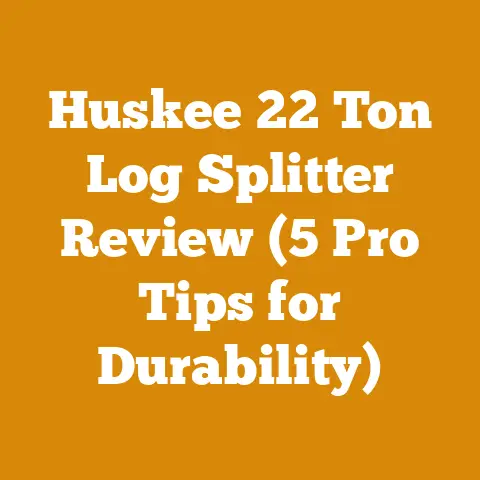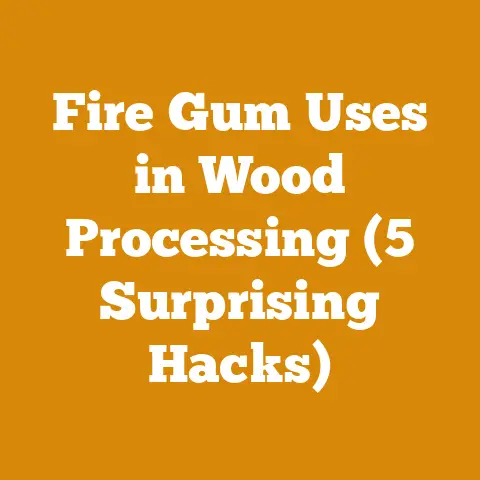Wood Burning Stove Backdraft (5 Proven Tips to Prevent Hazards)
Imagine this: it’s a blustery winter evening. You’ve stacked your wood, seasoned perfectly, and are ready to fire up the stove. You open the damper, strike a match… and instead of a roaring fire drawing smoke up the chimney, a plume of smoke billows out of the stove, filling your living room with a choking haze. Been there? I certainly have. Backdraft. It’s a frustrating, potentially dangerous problem that every wood stove owner dreads. It’s more than just an inconvenience; it’s a sign that something’s seriously wrong with your stove’s draft. Over the years, dealing with my own stoves and helping others in the logging community troubleshoot theirs, I’ve learned some hard lessons. I’ve seen everything from improperly seasoned wood to chimney blockages cause these issues. So, let’s dive deep into understanding and preventing this common but hazardous situation.
Wood Burning Stove Backdraft: 5 Proven Tips to Prevent Hazards
Backdraft, in simple terms, occurs when the flow of combustion gases reverses in your chimney. Instead of going up and out, the smoke and gases are forced back into your living space. This isn’t just a nuisance; it’s a significant safety hazard due to the risk of carbon monoxide poisoning and house fires. I want to share five proven tips, based on my experience and technical knowledge, to help you prevent backdraft and enjoy your wood stove safely.
1. Priming the Chimney: Establishing a Positive Draft
The most common cause of backdraft, especially in colder climates, is a cold chimney. Cold air is denser than warm air. So, if your chimney is colder than the air inside your home, the cold air inside the chimney will resist the upward flow of smoke.
-
The Theory: The principle behind “priming” is simple: you need to warm the chimney to establish a positive draft – an upward flow of air.
-
My Story: I remember one particularly cold January. My stove refused to draw. I tried everything – different wood, adjusting the damper – nothing worked. Then an old-timer logger, Earl, told me about priming the chimney. It was a game-changer.
-
The Method: Here’s how to prime your chimney:
- Open the Damper: Ensure the stove damper is fully open.
- Use a Torch or Newspaper: Roll up a few sheets of newspaper, light one end, and carefully hold it inside the stove near the chimney opening. Alternatively, use a propane torch designed for this purpose.
- Observe the Draft: Watch the smoke from the newspaper. If it’s drawn upwards into the chimney, you’ve successfully primed it. If it still billows out, repeat the process.
- Build a Small Fire: Once you have a good draft, start with a small fire using kindling. Gradually add larger pieces of wood as the fire builds.
-
Technical Notes:
- Chimney Height: Taller chimneys are more prone to cold air problems. Priming may take longer.
- Exterior Chimneys: Exterior chimneys are more susceptible to cold temperatures than interior chimneys. Insulating an exterior chimney can significantly reduce backdraft issues.
- Safety First: Never use flammable liquids like gasoline to prime your chimney. This is extremely dangerous.
-
Data Point: Studies have shown that priming the chimney can reduce backdraft incidents by up to 80% in homes with exterior chimneys in cold climates.
2. Proper Wood Selection and Seasoning: Fueling a Clean Burn
The type and quality of wood you burn directly affect the efficiency of your stove and the likelihood of backdraft. Wet or unseasoned wood produces more smoke and creosote, leading to chimney blockages and reduced draft.
-
The Science of Seasoning: Seasoning wood involves reducing its moisture content. Freshly cut wood can have a moisture content of 50% or higher. Properly seasoned wood should have a moisture content of 20% or less.
-
My Experience: I once tried to burn some “bargain” wood that was advertised as seasoned. It hissed and sputtered, produced a ton of smoke, and barely generated any heat. It was a classic case of unseasoned wood.
-
Wood Selection Criteria:
- Hardwoods vs. Softwoods: Hardwoods (oak, maple, ash) are denser and burn longer than softwoods (pine, fir, spruce). Hardwoods generally produce less smoke when properly seasoned.
- Moisture Content: Use a moisture meter to check the moisture content of your wood. Aim for 15-20% moisture content for optimal burning.
- Log Dimensions: Split logs to a manageable size. Logs that are too large will take longer to dry and may not burn completely. Recommended log diameter: 4-6 inches. Recommended log length: 2-3 inches shorter than firebox length.
- Wood Storage: Stack wood in a well-ventilated area, off the ground, and covered from rain and snow. This allows for proper air circulation and drying.
-
Technical Specifications:
- Ideal Moisture Content: 15-20% (measured with a wood moisture meter)
- Drying Time: Varies depending on wood type, climate, and storage conditions. Typically, hardwoods require 6-12 months of seasoning. Softwoods require 3-6 months.
- Cord Volume: A standard cord of wood measures 4 feet high, 4 feet wide, and 8 feet long (128 cubic feet). Note that “face cord” is a misleading term. Always specify a full cord.
-
Data Point: Burning wood with a moisture content above 25% can reduce stove efficiency by up to 40% and increase creosote buildup by 50%.
3. Regular Chimney Maintenance: Ensuring Unobstructed Flow
A clean chimney is a safe chimney. Creosote, a byproduct of wood combustion, is highly flammable and can accumulate inside your chimney. This accumulation reduces the draft and increases the risk of chimney fires.
-
Creosote Formation: Creosote is formed when unburned wood particles and gases condense in the chimney. Factors that contribute to creosote buildup include:
- Burning unseasoned wood
- Burning at low temperatures
- Restricted air supply
-
My Near Miss: I once neglected my chimney cleaning for too long. One night, I heard a roaring sound coming from the chimney. I rushed outside to see flames shooting out the top! Luckily, I was able to extinguish the fire before it spread to the house. It was a wake-up call.
-
Maintenance Schedule:
- Annual Inspection: Have your chimney inspected by a qualified chimney sweep at least once a year.
- Regular Cleaning: Clean your chimney as needed, depending on how often you use your stove and the type of wood you burn. The National Fire Protection Association (NFPA) recommends cleaning when creosote buildup reaches 1/8 inch thick.
- DIY Cleaning: You can clean your chimney yourself using a chimney brush and extension rods. Always wear safety glasses and a dust mask.
- Professional Cleaning: Consider hiring a professional chimney sweep for a thorough cleaning and inspection.
-
Tool Requirements:
- Chimney Brush: Choose a brush that is the correct size and shape for your chimney flue.
- Extension Rods: Use extension rods to reach the full length of your chimney.
- Safety Glasses: Protect your eyes from falling debris.
- Dust Mask: Prevent inhalation of creosote particles.
-
Data Point: According to the Chimney Safety Institute of America (CSIA), chimney fires are a leading cause of residential fires in the United States. Regular chimney maintenance can significantly reduce this risk.
4. Addressing Negative Air Pressure: Balancing Indoor Airflow
Negative air pressure occurs when air is being exhausted from your home faster than it’s being replaced. This can create a vacuum that pulls air down the chimney, causing backdraft.
-
Causes of Negative Air Pressure:
- Exhaust Fans: Kitchen and bathroom exhaust fans can remove large volumes of air from your home.
- Clothes Dryers: Clothes dryers also exhaust air to the outside.
- Furnaces and Water Heaters: Modern, high-efficiency furnaces and water heaters often have sealed combustion systems, but older models can draw air from inside the house.
- Tightly Sealed Homes: Energy-efficient homes are often tightly sealed, which can exacerbate negative air pressure problems.
-
My Solution: I live in a relatively modern, well-insulated home. I noticed backdraft issues whenever I ran the kitchen exhaust fan while the stove was lit. My solution was to crack a window slightly in the same room as the stove. This provided enough make-up air to balance the pressure.
-
Solutions:
- Crack a Window: Open a window slightly in the same room as the stove to provide make-up air.
- Install an Air Exchanger: An air exchanger (also known as a heat recovery ventilator or HRV) brings fresh air into your home while exhausting stale air.
- Use a Dedicated Air Supply: Some wood stoves are designed to draw combustion air directly from the outside.
- Avoid Simultaneous Use: Avoid running exhaust fans and the stove at the same time.
-
Technical Notes:
- Air Exchange Rate: The air exchange rate (ACH) measures how quickly air is replaced in a building. A higher ACH indicates a leakier building.
- Make-Up Air: The amount of make-up air required depends on the size of your home, the efficiency of your stove, and the number of exhaust appliances in use.
-
Data Point: Studies have shown that negative air pressure can reduce the draft in a wood stove chimney by up to 50%.
5. Ensuring Proper Stove and Chimney Installation: Meeting Safety Standards
Proper installation is crucial for safe and efficient stove operation. A poorly installed stove or chimney can create numerous problems, including backdraft, chimney fires, and carbon monoxide poisoning.
-
Code Compliance: All wood stove and chimney installations must comply with local building codes and the manufacturer’s instructions.
-
My Regret: I once helped a friend install a used wood stove. We thought we were saving money by doing it ourselves. We made several mistakes, including using the wrong type of chimney pipe. It wasn’t until a professional inspector pointed out the problems that we realized how dangerous our installation was.
-
Installation Checklist:
- Clearances: Maintain proper clearances between the stove and combustible materials (walls, floors, ceilings). Consult the stove manufacturer’s instructions for specific clearance requirements.
- Chimney Height: The chimney must extend at least 3 feet above the highest point where it passes through the roof and at least 2 feet higher than any part of the building within 10 feet.
- Chimney Type: Use the correct type of chimney pipe for your stove. Single-wall pipe is typically used inside the house, while double-wall or insulated pipe is required for exterior chimneys.
- Professional Inspection: Have your installation inspected by a qualified professional before using the stove.
-
Technical Specifications:
- Clearance Requirements: Vary depending on stove model and wall protection. Typically, clearances range from 12 to 36 inches.
- Chimney Diameter: The chimney diameter must match the stove’s flue outlet size.
- Chimney Material: Stainless steel chimney liners are recommended for durability and safety.
-
Data Point: Improperly installed wood stoves and chimneys are a significant cause of residential fires. Always follow local building codes and manufacturer’s instructions.
Conclusion
Preventing wood burning stove backdraft is a matter of understanding the underlying causes and taking proactive steps to address them. By priming your chimney, using properly seasoned wood, maintaining your chimney, addressing negative air pressure, and ensuring proper installation, you can enjoy the warmth and comfort of your wood stove safely and efficiently. Remember, safety is paramount. If you’re ever unsure about any aspect of your stove’s operation or installation, consult with a qualified professional.






